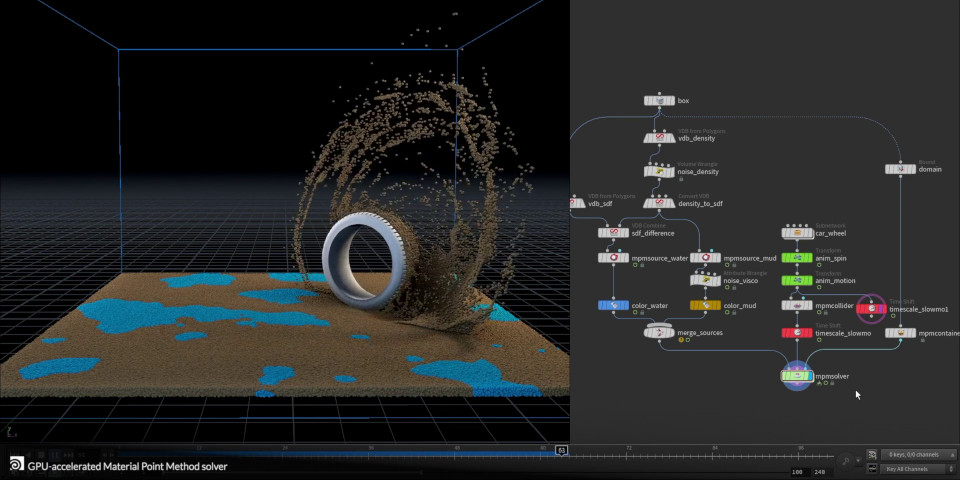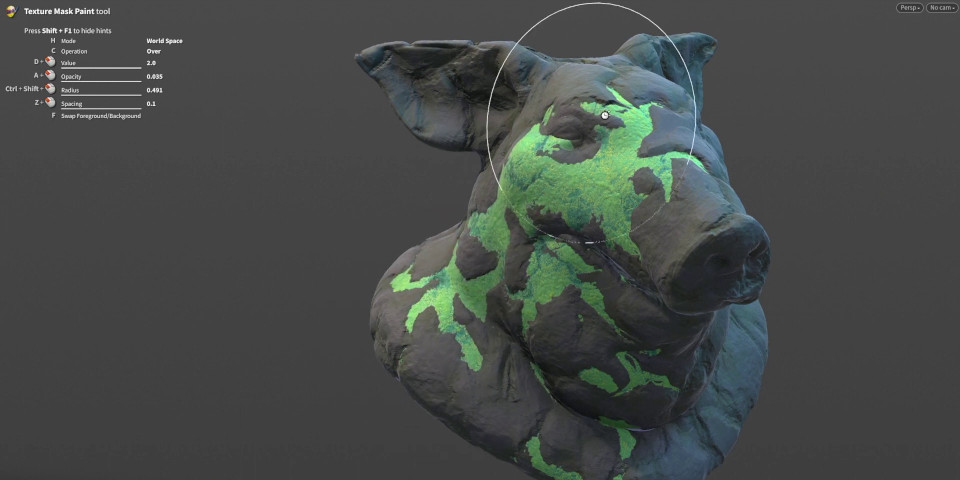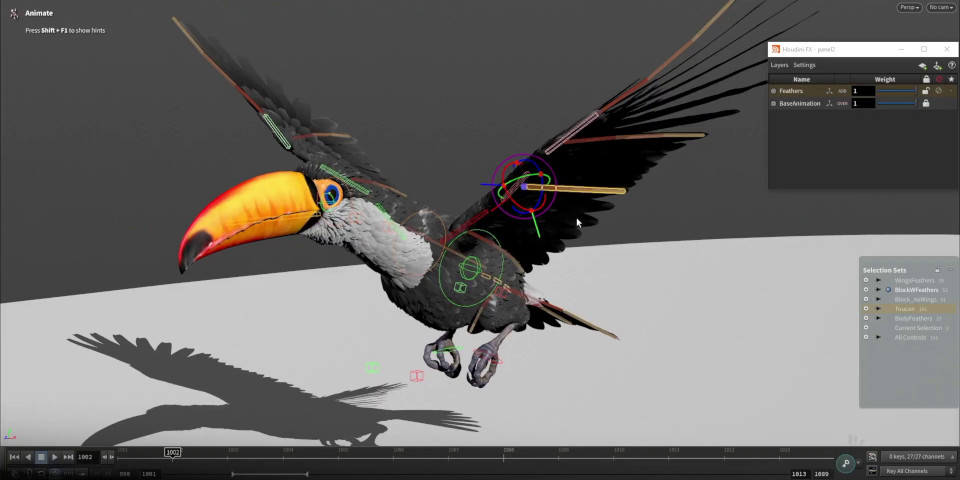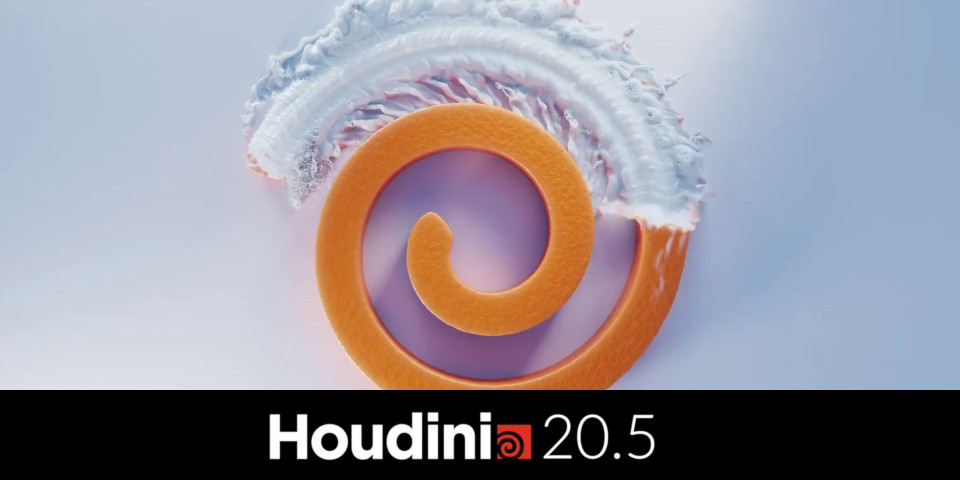Sneak peek: Houdini 20.5
Originally posted on 14 June 2024. Houdini 20.5 has now been released.
SideFX has released a sneak peek at Houdini 20.5, the next major version of its procedural 3D software for VFX, game development and motion graphics.
The video was premiered during the Annecy International Film Festival yesterday ahead of SideFX’s official launch presentation next week. The release itself is due for mid-July.
Another big update, with changes throughout Houdini’s key toolsets
Houdini 20.5 is another wide-ranging update, with new tools throughout production pipelines, from asset development to shot layout and rendering.
Highlights include a new MPM multi-material solver, new features in the KineFX character rigging and animation framework, and updates to the Karma renderers.
The update also introduces COPERNICUS, an experimental new context for Houdini’s COP compositing nodes that brings together 2D and 3D workflows.
Below, we’ve summarized the key changes, while at the foot of the story, you can find a fuller list of the features shown in the video.

New MPM solver for a range of materials, including sand and snow
Unusually for a Houdini update, the bulk of the new features aren’t simulation-related, although there is a new MPM (Material Point Method) solver.
Like the existing Vellum solver, it is capable of simulating a range of types of material: the video shows objects moving through granular materials like sand and snow.

COPERNICUS: an intriguing new context for Houdini’s COP nodes
Instead, the biggest new toolset is COPERNICUS, a “radically redesigned and re-envisioned context” for COPs, Houdini’s compositing nodes.
It has a “flexible architecture that brings together 2D and 3D”, and most of the features shown in the video are actually for material authoring and object scattering: the initial release supports only the “most basic” compositing.
Highlights include new 3D texture painting workflows, and new NPR (Non-Photorealistic Rendering) and toon shading capabilities for both geometry and volumes.

Updates to KineFX, Karma, the Vulkan Viewport and machine learning tools
KineFX, Houdini’s new-ish character rigging and animation framework, reaches its Beta 2 milestone, with new features including non-destructive animation layers.
Karma CPU and XPU, the CPU- and CPU/GPU-based versions of Houdini’s path tracing render engine, move closer together in feature parity, with sizeable updates to XPU.
The new Vulkan Viewport introduced in Houdini 20.0 is nearing feature parity with the old OpenGL viewport, and is now enabled by default.
And Houdini’s support for AI workflows continues to evolve, with a “dedicated SOP and TOP toolset to help automate ML training”.

All the key features shown in the Houdini 20.5 sneak peek
Below, you can find a list of the key features shown during the sneak peek. Most are showcased during the main part of the video, but SideFX also includes a high-speed title crawl at the end which lists more features, so in some cases, we’ve supplemented them with information from that.
3D modeling and retopology
• Fast sculpting with brush toolset for high-resolution meshes
• Planar inflate SOP for ‘cushy’ geometry
• Quad remeshing with guiding controls
COPERNICUS
COPERNICUS, Houdini 20.5’s new image-processing COP (compositing node) context is shown during the main video, but the summary at the end gives more context.
• Radically redesigned and re-envisioned COP context with over 150 nodes
• Fast, GPU-accelerated image processing framework written in OpenCL
• Optimized dual cooking engine under the hood: APEX and Traditional
• Flexible architecture that brings together 2D and 3D
• Images live in 3D with associated cameras
• Real-time image manipulation within a 3D space
• Unrestricted to SOP, DOP, LOP and any OP data
• Direct importing of volumes, height fields, meshes and attributes
• Lighting-fast Vulkan-based geometry rasterizer
• Comprehensive, live round-tripping mechanism via ‘op:’ syntax
• Live real-time visualization in 2D viewport, 3D viewport and Karma
• Powerful slap comp support for both interactive and offline workflows
• Built-in customizable framework for real-time viewport filters
• Robust support for video input
• Convenient creation and editing of OpenCL snippets at COP level
• VEX support available but not recommended for high performance
• Versatile SDF-based shape generators
• Powerful 2D and 3D noise generators
• Ability to scatter and stamp points
• Tileable pattern generators with unlimited creative controls
• Live, real-time response to interactive texture-mask painting in SOPs
• Procedural texture toolset with live 3D feedback
• Artist-friendly material creation environment
• Low-level support for NPR/toon shading of geometry and volumes
• Advanced edge detection and hatching algorithms
• Support for OpenFX standard
• Only the most basic compositing in Houdini 20.5: more to come later
• ML-ready via ONNX Inference node
KineFX
• Wing and feather rigging and animation
• Non-destructive animation layers
• Realtime ragdoll physics with posing
• OpenCL-based wrinkle deformer for realtime wrinkles (for skin and cloth)
The summary at the end of the video lists other changes, including:
• Interactive viewport tool for fast tagging of skeleton parts
• Python-style APEX scripting as an alternative to manual node graph editing
• 3D motion path handles
• OpenTImelineIO file support in bookmark editor
• Ability to reverse animation within selected frame ranges
• Fast and intuitive pose mirroring in world or local space
• Ability to weight joints as opposed to bones (for facial rigs, for example)
• Dedicated Vulkan shader for GPU-accelerated skin deformation
Simulation and dynamics
• GPU-accelerated MPM solver: multi-solver with presets for common material types
• RBD car rig with path animation, dynamic suspension and deformable tires
Solaris
• Crowd procedural for Karma and all Hydra delegates
Vulkan viewport
Houdini’s new Vulkan viewport isn’t namechecked during the main video, but there is some information in the summary at the end:
• Beta: nearly complete feature parity with OpenGL viewport
• Higher-quality display in many scenarios
• Enabled by default
Rendering
• Karma Atmosphere LOP with natural absorption and haze
• Karma XPU per-instance overrides: randomize color and intensity on instanced lights
The summary at the end of the video lists other changes, including:
• Blue noise support for better and less obvious noise patterns
• Slap comp support in Karma, Husk and ROPs
• Acceleration motion blur on curves and meshes
• USD-friendly lens shader workflow
• Support for OpenCV distortion contrasints in Karma Physical Lens VOP
• Open[Image]IO deep image support and EXR compatiblity with Nuke
• Karma XPU: 2-3x faster ray tracing shader excecution on NVIDIA Ada GPUs
AI and machine learning
The end of the video mentions a “dedicated SOP and TOP toolset to help automate ML training”.
Workflow improvements
• Recipes framework for parameter presets, Tab tool presets and node network presets
The end of the video also shows updates to Houdini’s Procedural Dependency Graph (PDG), and to Houdini Engine and its plugins.
Price, system requirements and release date
Houdini 20.5 is due for release in “mid July”. The current stable release, Houdini 20.0, is compatible with Windows 8+, macOS 11.0+, and Linux distros.
The software comes in several editions. The full edition, Houdini FX, costs $4,495 for a node-locked licence; $6,995 for a floating licence. Houdini Core, which lacks advanced simulation tools, costs $1,995 for a node-locked licence; $2,995 for a floating licence.
There is also a free Houdini Apprentice educational edition and a lower-cost, rental-only Houdini Indie edition. Both save in separate file formats. See a comparison table.
Read more about Houdini on SideFX’s website
(No more information on Houdini 20.5 at the time of writing)
Have your say on this story by following CG Channel on Facebook, Instagram and X (formerly Twitter). As well as being able to comment on stories, followers of our social media accounts can see videos we don’t post on the site itself, including making-ofs for the latest VFX movies, animations, games cinematics and motion graphics projects.
